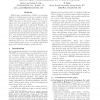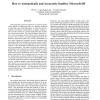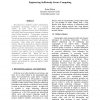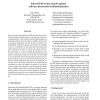ACSAC
2006
IEEE
14 years 5 months ago
2006
IEEE
An Intrusion Detection System (IDS) is a crucial element of a network security posture. Although there are many IDS products available, it is rather difficult to find information ...
ACSAC
2006
IEEE
14 years 5 months ago
2006
IEEE
Address-space randomization (ASR) is a promising solution to defend against memory corruption attacks that have contributed to about three-quarters of USCERT advisories in the pas...
ACSAC
2006
IEEE
14 years 5 months ago
2006
IEEE
Comparing the system call sequence of a network application against a sandboxing policy is a popular approach to detecting control-hijacking attack, in which the attacker exploits...
ACSAC
2006
IEEE
14 years 5 months ago
2006
IEEE
This work introduces the A system1 , an Internetbased, free and open source electronic voting system which employs strong cryptography. Our system is a fully functiona...
ACSAC
2006
IEEE
14 years 5 months ago
2006
IEEE
Attack graphs are a valuable tool to network defenders, illustrating paths an attacker can use to gain access to a targeted network. Defenders can then focus their efforts on patc...
ACSAC
2006
IEEE
14 years 5 months ago
2006
IEEE
ACSAC
2006
IEEE
14 years 5 months ago
2006
IEEE
We propose an architecture of four complimentary technologies increasingly relevant to a growing number of home users and organizations: cryptography, separation kernels, formal v...
ACSAC
2006
IEEE
14 years 5 months ago
2006
IEEE
Instruction Set Randomization (ISR) has been proposed as a form of defense against binary code injection into an executing program. One proof-of-concept implementation is Randomiz...
ACSAC
2006
IEEE
14 years 5 months ago
2006
IEEE
Network Intrusion Detection Systems (NIDS) have become crucial to securing modern networks. To be effective, a NIDS must be able to counter evasion attempts and operate at or near...
ACSAC
2006
IEEE
14 years 5 months ago
2006
IEEE
Sensor networks are deployed to monitor the physical environment in public and vulnerable locations. It is not economically viable to house sensors in tamper-resilient enclosures ...





